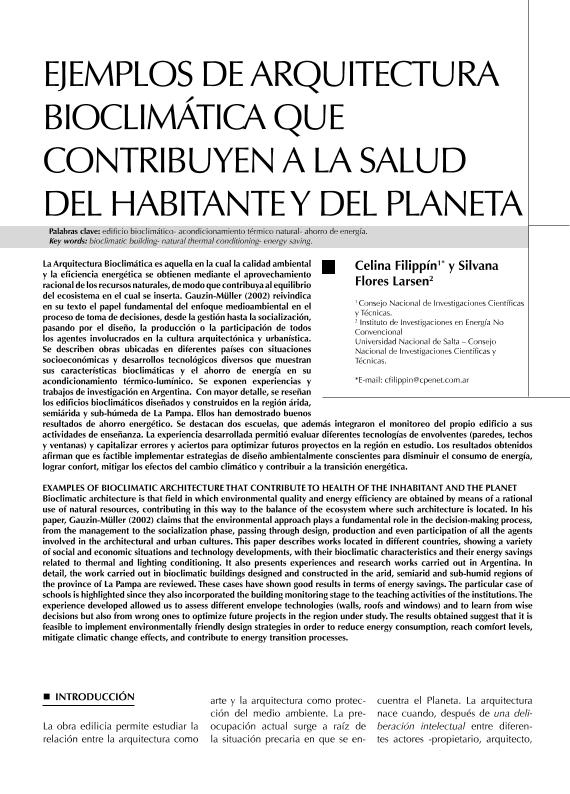Artículo
La Arquitectura Bioclimática es aquella en la cual la calidad ambiental y la eficiencia energética se obtienen mediante el aprovechamiento racional de los recursos naturales, de modo que contribuya al equilibrio del ecosistema en el cual se inserta. Gauzin-Müller (2002) reivindica en su texto el papel fundamental del enfoque medioambiental en el proceso de toma de decisiones, desde la gestión hasta la socialización, pasando por el diseño, la producción o la participación de todos los agentes involucrados en la cultura arquitectónica y urbanística. Se describen obras ubicadas en diferentes países con situaciones socioeconómicas y desarrollos tecnológicos diversos que muestran sus características bioclimáticas y el ahorro de energía en su acondicionamiento térmico-lumínico. Se exponen experiencias y trabajos de investigación en Argentina. Con mayor detalle, se reseñan los edificios bioclimáticos diseñados y construidos en la región árida, semiárida y sub-húmeda de La Pampa. Ellos han demostrado buenos resultados de ahorro energético. Se destacan dos escuelas, que además integraron el monitoreo del propio edificio a sus actividades de enseñanza. La experiencia desarrollada permitió evaluar diferentes tecnologías de envolventes (paredes, techos y ventanas) y capitalizar errores y aciertos para optimizar futuros proyectos en la región en estudio. Los resultados obtenidos afirman que es factible implementar estrategias de diseño ambientalmente conscientes para disminuir el consumo de energía, lograr confort, mitigar los efectos del cambio climático y contribuir a la transición energética. Bioclimatic architecture is that field in which environmental quality and energy efficiency are obtained by means of a rational use of natural resources, contributing in this way to the balance of the ecosystem where such architecture is located. In his paper, Gauzin-Müller (2002) claims that the environmental approach plays a fundamental role in the decision-making process, from the management to the socialization phase, passing through design, production and even participation of all the agents involved in the architectural and urban cultures. This paper describes works located in different countries, showing a variety of social and economic situations and technology developments, with their bioclimatic characteristics and their energy savings related to thermal and lighting conditioning. It also presents experiences and research works carried out in Argentina. In detail, the work carried out in bioclimatic buildings designed and constructed in the arid, semiarid and sub-humid regions of the province of La Pampa are reviewed. These cases have shown good results in terms of energy savings. The particular case of schools is highlighted since they also incorporated the building monitoring stage to the teaching activities of the institutions. The experience developed allowed us to assess different envelope technologies (walls, roofs and windows) and to learn from wise decisions but also from wrong ones to optimize future projects in the region under study. The results obtained suggest that it is feasible to implement environmentally friendly design strategies in order to reduce energy consumption, reach comfort levels, mitigate climatic change effects, and contribute to energy transition processes.
Ejemplos de arquitectura bioclimática que contribuyen a la salud del habitante y del planeta
Título:
Examples of bioclimatic architecture that contribute to health of the inhabitant and the planet
Fecha de publicación:
05/2023
Editorial:
Asociación Argentina para el Progreso de las Ciencias
Revista:
Ciencia e Investigación
e-ISSN:
2314-3134
Idioma:
Español
Tipo de recurso:
Artículo publicado
Clasificación temática:
Resumen
Archivos asociados
Licencia
Identificadores
Colecciones
Articulos(CCT - SAN LUIS)
Articulos de CTRO.CIENTIFICO TECNOL.CONICET - SAN LUIS
Articulos de CTRO.CIENTIFICO TECNOL.CONICET - SAN LUIS
Articulos(INENCO)
Articulos de INST.DE INVEST.EN ENERGIA NO CONVENCIONAL
Articulos de INST.DE INVEST.EN ENERGIA NO CONVENCIONAL
Citación
Filippin, Maria Celina; Flores Larsen, Silvana Elinor; Ejemplos de arquitectura bioclimática que contribuyen a la salud del habitante y del planeta; Asociación Argentina para el Progreso de las Ciencias; Ciencia e Investigación; 72; 5; 5-2023; 4-21
Compartir




